Home » Gemstones » Opal » Imitation Opal
Imitation Opal
A man-made material that looks like opal
Author: Hobart M. King, PhD, GIA Graduate Gemologist
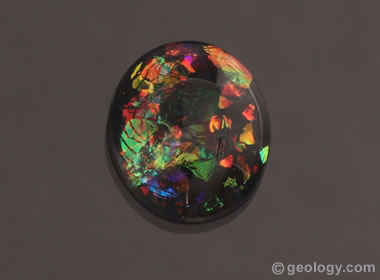
Slocum Stone: John Slocum developed a well-known and attractive imitation opal known as "Slocum Stone" or "Slocum Opal" in 1974. It is a silicate glass with opalescence produced by light interacting with thin translucent flakes of an iridescent film. [2] [3] The cabochon pictured above measures 15 x 12 millimeters.
Table of Contents
 What Is Imitation Opal? What Is Imitation Opal? Is Imitation Opal the Same as Synthetic Is Imitation Opal the Same as Syntheticor Lab-Grown Opal?  Identifying Imitation Opals Identifying Imitation Opals Opalescent Glass Opalescent Glass Should I Buy Imitation Opal Jewelry? Should I Buy Imitation Opal Jewelry? Are Imitation Opals "Fake"? Are Imitation Opals "Fake"? |
What Is Imitation Opal?
Imitation opal, also known as simulated opal, is a man-made material that has an opal-like appearance, but does not have all of the chemical, physical, and optical properties of natural opal.
Manufacturers of imitation opal strive to: (A) produce a material that looks like opal, and, (B) produce a material that can be sold at a lower price than natural opal of similar appearance. Their goal is to win customers who are interested in purchasing a natural opal, or, win sales from people who are simply looking for an attractive item.
Most imitation opals are made from glass, resin, or plastic. Some exhibit a colorful flash that is very similar to the play-of-color exhibited by natural opal. The best imitation opals exhibit a true play-of-color and cannot be separated from natural opals by visual observation alone. [1] Others fall far short of simulating natural opal, but they are marketable because they have an appearance that appeals to many people.
The purpose of manufacturing imitation opals is to provide a low-cost alternative gem for people who enjoy opal. Cabochons of many imitation opals sell for a few dollars per carat or less. An attractive imitation opal, in a sterling silver or low-karat-gold ring, can often be purchased for under $100.
A large amount of imitation opal is produced and cut into cabochons in Asia. Jewelry set with imitation opal is a common low-priced jewelry item sold throughout the United States. Some of the best imitation opal is mounted in precious metal settings and sold by many major jewelry chains.
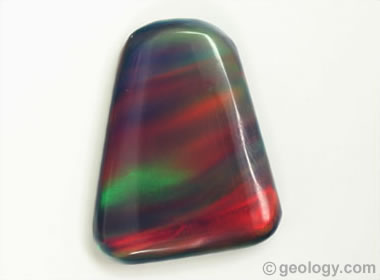
Aurora Opal: The attractive freeform cabochon above is an imitation opal known as Aurora Opal. It displays a true play-of-color in a swirly pattern. We sent this stone to the Gemological Institute of America's laboratory, and they identified it as an imitation opal. [4] The author believes that it was identified as imitation opal because it is composed mainly of resin and does not match the silica-dominated composition of natural opal. This specimen measures 25 x 20 millimeters.
Is Imitation Opal the Same as Synthetic or Lab-Grown Opal?
No.
To be called synthetic opal or lab-grown opal, a material must have the same: (A) chemical composition; (B) internal structure; (C) physical properties; and, (D) appearance as natural opal. Imitation opals fail to meet at least one of these four requirements.
Why do many imitation stones fall short of earning the synthetic label? (A) Some contain more resin than silica and thus do not match the composition of natural opal. (B) Some have a colorful flash produced by embedded pieces of film, instead of a play-of-color produced by an internal structure of silica spheres. (C) Some contain no water. (D) Some are crystalline instead of amorphous. In addition to these, there are other reasons why an opal might not earn the synthetic label.

Early Slocum Stone: An early example of Slocum Stone imitation opal, showing flat flake-like pieces of film that produce the different colors. This cabochon measures approximately 28 x 14 millimeters.
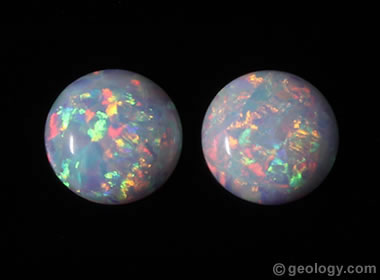
Imitation Opal With Play of Color: The ultimate accomplishment in imitation opal is to produce the play-of-color effect. This has been done and the product can be so convincing that many gemologists have difficulty separating them from natural opal - even with microscopic examination. The material has a high resin content with a lower specific gravity than natural opal - and a lower refractive index. If the stones are touched with a red hot probe "burnt plastic" odor will be produced - but this destructive test can not be done on many specimens.
Identifying Imitation Opals
Most imitation opals can easily be identified by an experienced gemologist. Often they can be identified by eye, but the best way to identify them is by microscopic examination.
Using a microscope, a gemologist can often determine that the "colorful display" of an imitation opal is caused by tiny particles of colored glass or colored film embedded in a clear medium.
Imitation opal made from glass will often contain small bubbles or swirl-shaped flow marks within or on the surface of the stone. These are best observed with a microscope and darkfield illumination.
Many imitation opals are now made mainly of plastic resin with a minor amount of silica. Some of these imitation opals can exhibit a true play-of-color. One of these has been marketed under the name "opalite". The play-of-color matches that of natural opal so closely that some gemologists - even with the aid of a microscope - have a difficult time identifying it as a man-made product. However, the high resin content of these opals changes other properties of the material. They usually have a lower specific gravity than natural opal and a lower refractive index.
If a person is willing to do a destructive test on an imitation opal, the material's high resin content allows it to be slightly indented with a small probe (some synthetic opals will flex under the probe). In addition, if the material is pressed with a metal probe that is hot enough to cause melting, it will produce a "burnt plastic" odor.
Experienced gemologists can usually identify imitation opal. However, some imitation opals have a convincing play-of-color, and the people who make them are getting better every year. If the gemologist is in doubt, the stone can be submitted to a laboratory for testing.
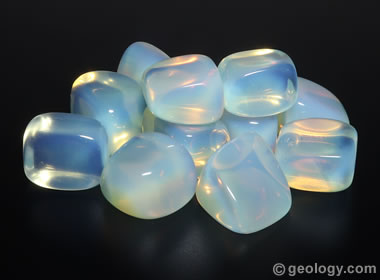
Opalescent Glass: Opalescent glass is a popular man-made opal imitation. It has a luster and translucence that triggers the name "opal" in many people's minds. It is often called "opalite". These tumbled stones are about one inch in size.
Opalescent Glass
Opalescent glass is one of the most commonly encountered opal simulants. It is a man-made glass with a luster or translucence that triggers the name "opal" in many people's minds.
Opalescent glass is popular as tumbled stones, cabochons, beads, figurines, and other items. These might be made by a lapidary or pressed in a glass studio.
Some opalescent glass has an appearance that is produced by cooling the molten glass very slowly - which causes the formation of tiny crystals within the glass. [5] These tiny crystals scatter light passing through the glass to create a milky translucence and pearly appearance.
Some opalescent glass exhibits the Tyndall effect by appearing blue when illuminated on its surface and appearing orange when light is transmitted through it. [6] An example of this material is the opalescent glass in the accompanying photo.
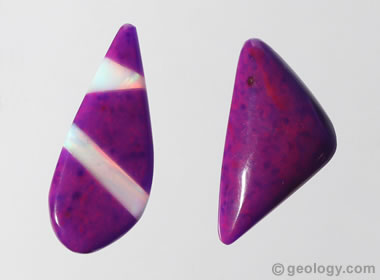
Imitation Opal and Sugilite: The cabochon on the left is an assembled stone made by artistically combining pieces of imitation sugilite and imitation opal. The purple material in these cabochons is made of powdered sugilite, pressed into a mold and bound together by resin. The mixture of resin and sugilite is a man-made product. It is thus considered to be imitation sugilite. It is not natural, does not meet the definition of synthetic, and because it was made to look like sugilite, it is an imitation. The cab on the left measures 20 x 50 millimeters, and the cab on the right measures 23 x 45 millimeters.
Should I Buy Imitation Opal Jewelry?
Imitation opals are legitimate products that can look great in jewelry, and many people enjoy them. If you find an imitation opal that you like and want to wear, there is nothing wrong with buying it. You should expect to pay a lot less for an imitation opal than you would pay for a natural opal of similar size and appearance.
Just like natural opal, imitation opal must be worn and stored with care. Most imitation opals have a hardness that is much lower than that of other gems. Thus, they can be easily scratched or abraded if they are bumped or scuffed against many common objects. This makes them a vulnerable stone in a ring, and a stone that is more suited for a pendant, pin, or earrings.
Imitation opal should not be cleaned with a harsh detergent or chemical cleaner and never washed with an abrasive cleanser. The best way to clean them is by washing with warm water, a mild soap, and a soft clean cloth.
Imitation opal should be stored in a jewelry box or a jewelry bag where long-term exposure to light will not fade the color of the stone. They should be stored in a way that they will not be in contact with other jewelry items to prevent abrasion.
| Imitation Opal Information |
|
[1] "Opalite": Plastic Imitation Opal With True Play-of-Color: by John I. Koivula and Robert C. Kammerling; article published in Gems & Gemology, Volume 25, Number 1, pages 30 to 34, Spring 1989.
[2] Observations on the Slocum Stone: by Pete J. Dunn; article published in Gems & Gemology, Volume 15, Number 8, pages 252 to 256, Winter 1976-1977. [3] Slocum Stone - A New Man-Made Material: by Mike Schowalter; article published in Lapidary Journal, September 1976 issue, pages 1370 to 1374. [4] Gemological Report 5202505180 issued by the Gemological Institute of America Laboratory, August 12, 2019. [5] Opalescent Glass: by Angela M. Bowey; an article on The Glass Museum website, last accessed July 2022. [6] Tyndall Effect: an article on the Wikipedia.org website, last accessed July 2022. [7] Guides for the Jewelry, Precious Metals, and Pewter Industries: a guidance document for industry from the Federal Trade Commission, The Federal Register, Volume 83, Number 159, 11 pages, August 16, 2018. |
Are Imitation Opals "Fake"?
No. They are imitation opals.
The word "fake" is often used to imply a deceptive or fraudulent product. As long as the seller properly calls their product an imitation opal, an opal simulant, or an "opal-like product" it is neither deceptive nor fraudulent.
Manufacturing imitation materials is not illegal, immoral, deceptive, or fraudulent. It is an acceptable business activity. But, if a seller offers an imitation opal for sale and claims that it is a natural opal, then those false claims could be considered to be illegal, immoral, deceptive, fraudulent, or even criminal.
The Federal Trade Commission provides guidance on how synthetic and imitation materials should be described and disclosed in the marketplace. They also advise people who sell natural materials to be careful with language that disparages synthetic materials. [7] The author predicts that a future update of the Federal Trade Commission's Jewelry Guides will advise against using the word "fake" for synthetic and imitation materials.
| More Gemstones |
 |
Tourmaline |
 |
Fancy Sapphires |
 |
Diamond |
 |
Canadian Diamond Mines |
 |
Birthstones |
 |
Pictures of Opal |
 |
Fire Agate |
 |
Blue Gemstones |

Find Other Topics on Geology.com:

|

| ||

|

| ||

|

| ||

|

|
